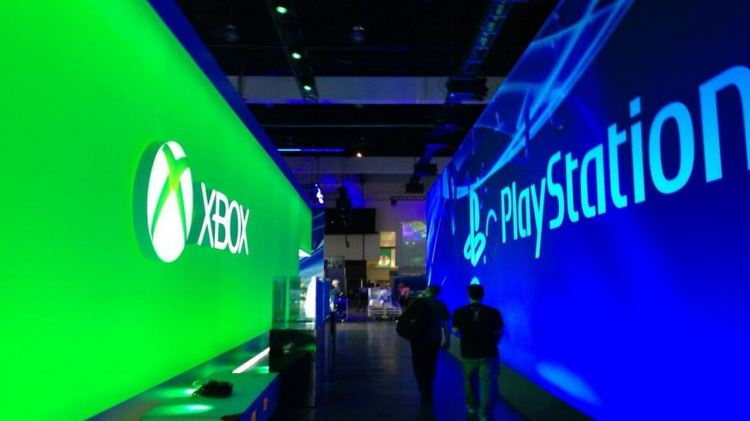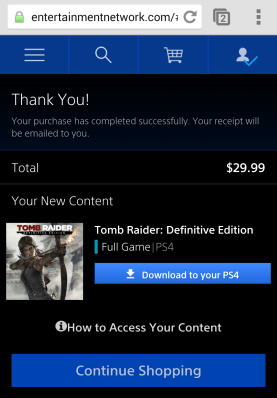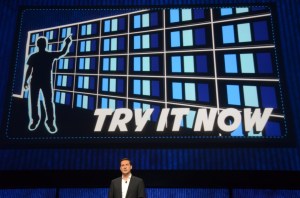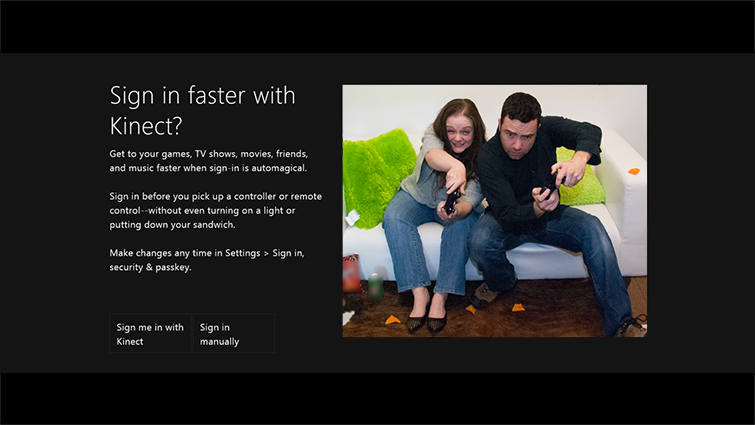Sony and Microsoft have both made a lot of promises to us over the last year about the PlayStation 4 and Xbox One. Some they’ve kept — others have yet to materialize.
It makes sense that the hardware companies would want to promise the world. After all, it’s difficult to get people to spend $400 or $500 on something that doesn’t play a ton of games yet. Naturally, this leads to the companies laying out bold visions of our livestreaming all-in-one future … visions that they don’t necessarily deliver on right away.
Both companies are still adding features — in fact, yesterday, Microsoft finally revealed that the Xbox One will support external hard drives. This is something it talked about at last year’s Electronic Entertainment Expo trade show in June.
With that in mind, we decided to look back and compare the Xbox One and PlayStation 4 systems of today with some of the big, select promises each company made over the last year and more.
PlayStation 4 promises
Promise No. 1: Remote purchasing and installing games and apps
Selling a new console requires a manufacturer to sell gamers on the idea of the future. To do that, Sony promised that gamers could buy software from anywhere using their smartphone that would automatically install on the PS4. Game boss Shuhei Yoshida explained the process in a tweet in August.
@SyriasSerj When you buy a PS4 game on smartphone, it will wake your PS4 up to start downloading the game. PS4 goes back to sleep after that
— Shuhei Yoshida (@yosp) August 27, 2013
Yoshida told a fan that when he used the PlayStation app to buy a game the PS4 would remotely power up, download and install the software, and then power down.
Does it work?
Fans love this idea. Yoshida’s tweet made headlines and drew a ton of attention on message boards. The good news for fans is that this function works as advertised as long as you keep your PlayStation 4 in standby mode.
I gave this feature a shot, and it worked without issue.
I booted up the PlayStation app on my Nexus 5 while out for a walk I clicked through to the store, bought Tomb Raider: Definitive Edition for $30, and clicked the install button that popped up immediately. Back at home, my PS4 was whirring up to download and install Lara Croft’s latest adventure.
When I got back, I booted up my PS4 to see the game installed and ready to go.
Promise No. 2: Suspend games and resume them instantly later
Games have never worked like books or movies. You can pop a bookmark into a novel to pick it up again from where you left off instantly. On PlayStation 3, when you shut down your system, you had to first find a checkpoint or a save to ensure you could keep playing without losing any progress.
Sony wanted to fix that with the PS4. When the company announced the console, it revealed a feature that would enable players to suspend and instantly resume their games. This would essentially enables gamers to pause a game and continue it later even after turning the console off and back on. No more clicking through the title menu every time the game loads up to select the correct save file — like a bookmark, the PS4 would just open up directly to the page you were on.
Does it work?
No, it doesn’t work because Sony has not added this feature to the PS4 yet.
We reached out to the company to ask if gamers can expect this feature any time soon, but Sony has not responded to our request.
Promise No. 3: Stream demos instantly
In July 2012, Sony acquired game-streaming service Gaikai. Since then, the two companies have worked together to build PlayStation Now, which will enable gamers to play PlayStation 3 and other games instantly from the cloud. That service is coming soon. It is in a beta test now, but during its February 2013 reveal event, Gaikai boss David Perry talked about how Sony would use the cloud to stream PlayStation 4 demos as well.
“With Gaikai and the PS Store, you’ll be able to instantly experience anything you want,” Perry said during his presentation. “Try it for free, share if you like it, and pay only if you like it.”
This is the kind of technology that Gaikai was offering to third-party publishers before the Sony acquisition, so it’s something that makes a lot of sense for the PS4 — especially since demo games can take up a lot of hard drive space and a lot of time to download.
Does it work?
So far, demo streaming is another no-show. Again, we reached out to Sony for more information, and we’re waiting for something specific.
It’s possible that Sony has its Gaikai team focused on finishing PlayStation Now, which is a potentially huge new product. Once that system is in place, maybe Gaikai will finally deliver its promise of PS4 game demos.
Xbox One promises
Promise No. 1: Kinect can read your pulse
Xbox One won’t always come bundled with its Kinect camera. Microsoft announced last week that it is releasing a version of the console without Kinect for $400. This likely means less support for the device, but does that even matter? Well, Microsoft always positioned the camera as a high-tech tool central to its all-in-one entertainment future. A big part of that was just how advanced the optical sensors are on Kinect. A prime example of that is how the Kinect can read a person’s pulse just by looking at them.
The idea is that a person could boot up the Xbox Fitness app and get a quick idea of the effect the exercise is having. Kinect apparently gets the BPM by reading a person’s skin temperature and tone.
Does it work?
The Xbox Fitness app included with Xbox One tracks players a number of ways. You can see an an outline of your body that shows you what part of your anatomy is doing the work, and, yes, the system occasionally updates you with your heartbeat.
I booted up Xbox Fitness and jumped around like one of them healthy people for a few minutes. The app regularly updated me about my heartbeats per minute, so it’s at least providing me some sort of feedback. I’m just not sure it’s entirely accurate feedback.
When I first started, Kinect was telling me that I had a BPM of 136. That seemed a bit high as I hadn’t really done anything yet. I decided to check it myself, so I tracked my pulse over a 60-second period … and I got between 84 BPM and 86 BPM.
Other times Kinect got a bit closer to what I was getting, but it was wrong more than it was right.
Promise No. 2: Suspend games and resume them instantly later
Yeah, we just did this for PS4, but Microsoft promised the same thing for Xbox One. Both companies were promising instant gratification with their machines, so it’s no surprise they came up with the idea to let gamers pick up right from where they left off.
Does it work?
Yes. Actually, it works really well. Unlike PS4, the Xbox One launched with a feature called “Resume game quickly. This functionality, which was still in beta and turned off by default, enabled gamers to turn off their system without having to worry about losing any progress … four out of five times. While the instant-resume feature was in beta, it didn’t always work. But it’s out of beta now, and it seems to work most of the time. When it does fail, the worst that happens is you have to pick up from your last checkpoint.
Now, when Xbox One owners turn their system back on, the system will boot right back up with the game ready and waiting. It’s actually quite amazing.
Promise No. 3: Kinect will automatically load your controller profile when it sees you
Passing controllers around a party — or even when you only have a couple of people — can usually lead to some frustrations. I play all of my games with inverted controls, so, invariably, when I hand off the sticks to someone else they freak out, pause the game, dig through the options, and switch the controls back to direct. When I get the controller back, I have to do the same thing.
Microsoft thought up a fix to this problem. It has the Kinect detect who is holding the controller and automatically switches profiles based on who is holding it. No more trying to rewire your brain to get it to work with someone else’s control scheme. No more fumbling through menus every time it’s your turn.
Does it work?
This is one of those Kinect features that doesn’t seem like it would actually work, but it does most of the time and in certain circumstances. If I hand the controller to my wife, and she holds it up so the Kinect can see it, it typically logs in her controller profile.
But this isn’t going to eliminate problems in every situation. If you have a group of friends over, and they don’t have gaming profiles on your Xbox One, then the system will just leave you logged in when you hand the controller off to the guest. Still, they could always just log in with their Xbox Live account or make one of their own, and then it isn’t a problem for the rest of the night.
Promise keepers
While Microsoft and Sony still haven’t fully delivered on everything, they’ve come close.
Sony came through with most of its features on day one, but it’s even started adding some new stuff through updates. Microsoft, on the other hand, has had to release some basic functionality in the months since November, but its monthly Xbox One updates make it seem like it will get to everything eventually. Next month’s E3 will likely bring with it another round of promises as the hardware companies seek to build up their install base, and we’ll be sure to check in to see if they follow through.
VentureBeat's mission is to be a digital town square for technical decision-makers to gain knowledge about transformative enterprise technology and transact. Learn More





